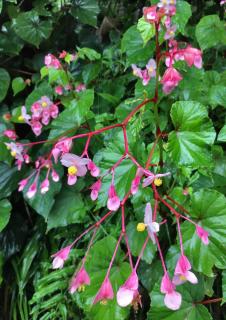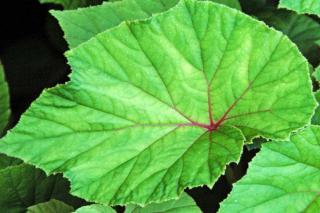

Begonia grandis displays magnificent blooming that is abundant and spectacular.
Name – Begonia grandis
Common names – hardy begonia, perennial begonia, Evan’s begonia
Family – Begoniaceae
Type – perennial
Flowering – Summer
Height – 16 to 20 inches (40 to 50 cm)
Exposure – sun and part sun
Soil – rather rich, well drained
Planting and care are major factors ensuring better growth and flowering for Begonia grandis.
Begonia grandis is one of the few of its species to be hardy and to successfully cope with winter freezing. When planting your grandis begonia, ideally, you’d use flower plant soil mix or a mix of leaves and soil mix.
 Plant anytime from April onwards, directly in the ground, preferably in a partly shaded spot. In the ground or in a garden box, keep a buffer space of about 12 to 16 inches (30-40 cm) from one plant to the next.
Plant anytime from April onwards, directly in the ground, preferably in a partly shaded spot. In the ground or in a garden box, keep a buffer space of about 12 to 16 inches (30-40 cm) from one plant to the next.
Begonia grandis develops bulblets in Autumn. These appear at the point where its stems split. Bulblets help the plant spread and multiply naturally.
 The care that begonia requires is quite easy, especially once it has settled in well. It only requires very little care, and will do just as well in a flower bed as it will in a pot, garden box or container. The only important thing is to remember to water your begonia grandis when they’re in pots, garden boxes and the like, as soon as the soil mix is dry in the surface: it needs constantly moist soil. Begonia grandis requires lots of water, even more so when grown out of the ground in containers like pots and garden boxes.
The care that begonia requires is quite easy, especially once it has settled in well. It only requires very little care, and will do just as well in a flower bed as it will in a pot, garden box or container. The only important thing is to remember to water your begonia grandis when they’re in pots, garden boxes and the like, as soon as the soil mix is dry in the surface: it needs constantly moist soil. Begonia grandis requires lots of water, even more so when grown out of the ground in containers like pots and garden boxes.
Native to Asia (China and Japan essentially), Begonia grandis comes in many shapes and colors. It originally developed in the wild in forest undergrowth, with lots of shade and rich soil with lots of humus.
Considered an herbaceous plant since it has no stem, it is part of the group of plants that are typically called bushes. Its striking bright colors range from yellow to red and pink, and they’ll irradiate all the more that the begonia is made to grow in a good quality substrate.
If you’re looking for an indoor begonia, you might want to look at the elegant begonia tamaya.
Since it needs lots of moisture in the soil, it’s a good idea to spread the right mulch for moisture to stay in the soil. Use either clay pebbles or any type of plant mulch. You’ll save on watering!